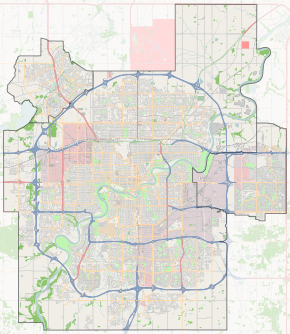Beverly Heights, Edmonton
| Beverly Heights | |
|---|---|
| Neighbourhood | |
 Beverly Heights Location of Beverly Heights in Edmonton | |
| Coordinates: 53°33′58″N 113°24′14″W / 53.566°N 113.404°W | |
| Country |
|
| Province |
|
| City | Edmonton |
| Quadrant[1] | NW |
| Ward[1] | 7 |
| Sector[2] | Mature area |
| Area[3][4] | Beverly |
| Government[5] | |
| • Administrative body | Edmonton City Council |
| • Councillor | Tony Caterina |
| Area[6] | |
| • Total | 1.38 km2 (0.53 sq mi) |
| Elevation | 655 m (2,149 ft) |
| Population (2012)[7] | |
| • Total | 3,200 |
| • Density | 2,318.8/km2 (6,006/sq mi) |
| • Change (2009–12) |
|
| • Dwellings | 1,777 |
Beverly Heights is a neighbourhood in east Edmonton, Alberta, Canada. Originally part of the Town of Beverly, Beverly Heights became a part of Edmonton in 1961 when the town amalgamated with Edmonton.
The neighbourhood is bounded on the south by the North Saskatchewan River valley, on the north by 118 Avenue, on the west by 50 Street, and on the east by 34 Street and 36 Street.
There are four schools in Beverly Heights, the Beverly Heights Public School, the Lawton Junior High School, the R.J. Scott Elementary School, and the St. Nicholas Catholic Junior High School.
Lawton Junior High School was the first junior high school in the Town of Beverly, and is named after Percy Benjamin Lawton. Lawton was a teacher, principal, Supervisor of Beverly Schools, and superintendent. He also served briefly as mayor of the Town of Beverly.[8]
The Beverly Cenotaph, originally built to remember the men from Beverly who served and died in World War I, is located in Beverly Heights. The original dedication ceremony was held on October 17, 1920, making the cenotaph the first to be erected in the Edmonton area, and one of the earliest in Alberta. The cenotaph was expanded and rededicated in 1958.[9]
Demographics
In the City of Edmonton's 2012 municipal census, Beverly Heights had a population of 3,200 living in 1,777 dwellings,[7] a -5.2% change from its 2009 population of 3,375.[10] With a land area of 1.38 km2 (0.53 sq mi), it had a population density of 2,318.8 people/km2 in 2012.[6][7]
Mining
The Town of Beverly was a coal mining town with over twenty mines operating in the area during the town's history. The following major mine was active in area of Beverly Heights.
- Bush (Davidson) Mine
Surrounding neighbourhoods
 |
Newton | Beacon Heights | Abbottsfield |  |
| Highlands | |
Rundle Heights | ||
| ||||
| | ||||
| North Saskatchewan River | North Saskatchewan River | North Saskatchewan River |
References
- 1 2 "City of Edmonton Wards & Standard Neighbourhoods" (PDF). City of Edmonton. Archived from the original (PDF) on May 3, 2014. Retrieved February 13, 2013.
- ↑ "Edmonton Developing and Planned Neighbourhoods, 2011" (PDF). City of Edmonton. Archived from the original (PDF) on September 4, 2013. Retrieved February 13, 2013.
- ↑ "The Way We Grow: Municipal Development Plan Bylaw 15100" (PDF). City of Edmonton. 2010-05-26. Archived from the original (PDF) on May 2, 2015. Retrieved February 13, 2013.
- ↑ "City of Edmonton Plans in Effect" (PDF). City of Edmonton. November 2011. Archived from the original (PDF) on October 17, 2013. Retrieved February 13, 2013.
- ↑ "City Councillors". City of Edmonton. Retrieved February 13, 2013.
- 1 2 "Neighbourhoods (data plus kml file)". City of Edmonton. Retrieved February 13, 2013.
- 1 2 3 "Municipal Census Results – Edmonton 2012 Census". City of Edmonton. Retrieved February 22, 2013.
- ↑ "Herzog, Lawrence, "Built on Coal, A History of Beverly, Edmonton's Working Class Town", Beverly Community Development Society, 2000, Edmonton, Alberta.
- ↑ Herzog pp. 99-100
- ↑ "2009 Municipal Census Results". City of Edmonton. Retrieved February 22, 2013.